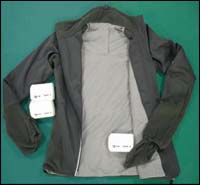Interviews
Smart/interactive clothing to be next area of growth
26 Oct '09
9 min read

SmartShirt has enormous potential for applications in fields such as telemedicine, monitoring of patients in post-operative recovery, the prevention of SIDS (sudden infant death syndrome), and monitoring of astronauts, athletes, law enforcement personnel and combat soldiers. The garment can be configured in many ways and attached to almost any sensor including global positioning device.
A totally new area is applying conductive polymers to photovoltaic fibers in the development of textile based solar cells. Konarka Technologies Inc., an innovator in developing and commercializing power plastics that convert light to energy, has already demonstrated it can produce a working photovoltaic fiber. The company is collaborating in a long term alliance with a Swiss company to develop photovoltaic fabric in which solar power generating properties are woven into the fabric rather than applied to the fabric surface.
The market for smart fabrics and interactive textiles (SFITs) is likely to exceed US $640 million as per a report by Research and Markets. This figure is well in excess of the figure of US $485 million predicted in 2005. Moreover, the compound annual growth rate (CAGR) of 18% earlier forecast for 2004-08 has become as high as 27%. The bulk of turnover in SFITs is generated in the production of intermediate components, or SFIT modules—a sector involved in combining base electronic components into a textile substrate.
However, this sector is growing by a relatively slow 19% per annum, whereas finished SFIT-based textiles are growing by 76% per annum. The biggest single end use for SFITs continues to be heated automotive seating. But other applications are expected to catch up and overtake it, particularly textiles for physiological sensing. Demand for SFITs for military use also continues to be strong.
One of the most important technical developments in SFITs has been the replacement of metallic fibres with conductive polymers such as, polypyrrole and polyaniline. In addition, there have been important developments in fibres coated with conductive metals. A further area of major promise is the use of nanotechnology, including carbon nanotubes, provided that, concerns over potential health hazards can be resolved.
The SFIT industry is characterised by the presence of a large number of relatively small companies. This is a consequence of the diversity of technical expertise involved and the wide variety of developments which have emerged. In this business environment, smaller enterprises are able to occupy profitable technological niches.
Larger companies, by contrast, have been reluctant to enter the SFIT market. The industry is also characterised by strategic alliances and partnerships—despite low levels of competition. These have been seen as solutions to problems arising from limited production capacities and high costs of research and marketing.
For the future, a number of issues will need to be addressed as the industry develops. One is the lack of industry standards. Another is the need for more professional marketing. Of particular importance is the need to bring down the cost of manufacture—and hence selling prices.
A totally new area is applying conductive polymers to photovoltaic fibers in the development of textile based solar cells. Konarka Technologies Inc., an innovator in developing and commercializing power plastics that convert light to energy, has already demonstrated it can produce a working photovoltaic fiber. The company is collaborating in a long term alliance with a Swiss company to develop photovoltaic fabric in which solar power generating properties are woven into the fabric rather than applied to the fabric surface.
The market for smart fabrics and interactive textiles (SFITs) is likely to exceed US $640 million as per a report by Research and Markets. This figure is well in excess of the figure of US $485 million predicted in 2005. Moreover, the compound annual growth rate (CAGR) of 18% earlier forecast for 2004-08 has become as high as 27%. The bulk of turnover in SFITs is generated in the production of intermediate components, or SFIT modules—a sector involved in combining base electronic components into a textile substrate.
However, this sector is growing by a relatively slow 19% per annum, whereas finished SFIT-based textiles are growing by 76% per annum. The biggest single end use for SFITs continues to be heated automotive seating. But other applications are expected to catch up and overtake it, particularly textiles for physiological sensing. Demand for SFITs for military use also continues to be strong.
One of the most important technical developments in SFITs has been the replacement of metallic fibres with conductive polymers such as, polypyrrole and polyaniline. In addition, there have been important developments in fibres coated with conductive metals. A further area of major promise is the use of nanotechnology, including carbon nanotubes, provided that, concerns over potential health hazards can be resolved.
The SFIT industry is characterised by the presence of a large number of relatively small companies. This is a consequence of the diversity of technical expertise involved and the wide variety of developments which have emerged. In this business environment, smaller enterprises are able to occupy profitable technological niches.
Larger companies, by contrast, have been reluctant to enter the SFIT market. The industry is also characterised by strategic alliances and partnerships—despite low levels of competition. These have been seen as solutions to problems arising from limited production capacities and high costs of research and marketing.
For the future, a number of issues will need to be addressed as the industry develops. One is the lack of industry standards. Another is the need for more professional marketing. Of particular importance is the need to bring down the cost of manufacture—and hence selling prices.
Popular News
Leave your Comments
Editor’s Pick
Folker Stachetzki
Brother Internationale Industriemaschinen GmbH
Andreas Rass
ZIMMER AUSTRIA | Digital Printing Systems
Pratik Gadia
The Yarn Bazaar - Filosha Infotech Private Limited
































-Ltd..jpg?tr=w-120,h-60,c-at_max,cm-pad_resize,bg-ffffff)





.jpg?tr=w-120,h-60,c-at_max,cm-pad_resize,bg-ffffff)
.jpg?tr=w-120,h-60,c-at_max,cm-pad_resize,bg-ffffff)






